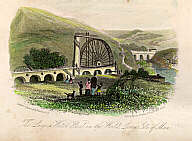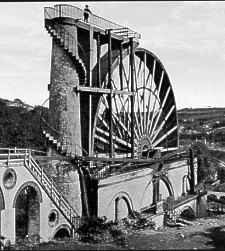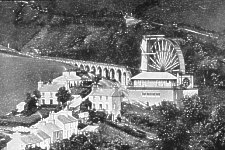

Photo shows wheel c.1910

The arched viaduct can be clearly seen feeding the drive back to the mine workings
The most visible remains of a once extensive mining industry.
Built 1854, to a design by local enginer Robert Casement, in order to drain the Laxey Mines some 200 yards up the valley. Starteded 27 September 1854 by Lieutenant Governor Hope, after whose wife the company named the wheel.
The wheel diameter is 72½ feet, breadth 6 feet and when working ran at some 2½ rpm (though this could be increased to 4). It produced an estimated 200hp transmited to the pumps by the shaft carried on oiled bearings supported on the viaduct. The shaft moves 10 feet with each revolution - a cranked arm transforming the rotary motion into a linear to-and-fro motion.
The Wheel is pitch back shot, supplied from a reservoir higher up the valley. Water is fed along an iron tube, up the tower and then onto the wheel which rotates counter-clockwise as viewed in the engraving below.
| It soon became a tourist attraction and featured in all guides. For a description of it and the Laxey Washing floors see chapter XI of Leech's guide of 1861. |  |
|
 Photo shows wheel c.1910 |
 The arched viaduct can be clearly seen feeding the drive back to the mine workings |
|
Original company went into voluntary liquidation in 1901 when a working struck an underground river with the result that the mine was no longer viable as ore deposits had been worked out and cheaper imports were available. A new company was formed in 1903 and installed additional pumps but a strike by its workforce in 1907 almost crippled it. It continued to 1920 when another strike finally saw it close - for this last period lead ore production was little more than 10% of its peak, zinc-blende was down to 20% but the company appears to have improved extraction of Silver from the lead-ore. As Bawden et al only quote silver extraction for 1913 it is possible that this year saw an attempt to rework the spoils. Figures for the war years drop sharply as many men left to fight. A new company was founded in 1920 by the Williamson's (proprietors of Laxey Glen), but even after a £4000 grant from the Manx governement did not succeed in finding any new workable deposits and the mine closed in 1929.
Acquired in 1965 by Manx National Heritage and restored to working order and appearance as built. Now forms centrepiece in MNH Mines Trail tourist attraction.
Anders Jespersen The Lady Isabella Waterwheel of the Great Laxey Mining Co., Isle of Man 1854-1954 Copenhagen: pub by author: Virum [1954] (detailed study especially of the water catchment area)
Anders Jespersen The Big Wheel (Lady Isabella) Laxey Isle of Man History and Description of this Famous Landmark Douglas: Examiner Works 1954 (20p pbk based on above)
G.N. Kniveton Lady Isabella and the Great Laxey Mine. Official Guide Douglas: Manx Experience [1990] (excellent)
Andrew Scarffe The Great Laxey Mine Douglas Manx National Heritage 2004 (ISBN 0 9547 180 2 X) (the reference book)
T.A.Bawden, L.S. Garrad, et al The Industrial Archaeology of the Isle of Man Newton Abbot: David & Charles 1972 (ISBN 0-7153-5440-X) (pp65/66)
| Laxey | ||
|
|
||
|
Any comments, errors or omissions
gratefully received The
Editor |
||